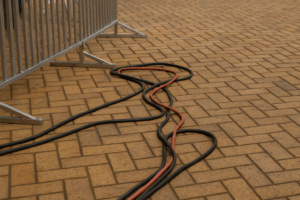
According to the National Elevator Industry, Inc., there are more than 1.03 million elevators in the United States, and California has the highest share, with over 145,000 in operation. In this state, elevators and escalators are undeniably part of daily life, may it be in office towers, shopping malls, hospitals, or apartment buildings.
With so many in use, even a single failure can have serious consequences.
To keep riders safe, California enforces strict regulations, including unique seismic safety requirements that apply to elevators, escalators, and moving walks. When those standards aren’t met and someone is injured, victims may have the right to pursue a claim.
In this article, we’ll explain who regulates elevators in California, what codes apply to their safety, common causes of accidents, how liability works, and what steps you can take if you’ve been hurt in an elevator or escalator incident.
In a state with more than a hundred thousand elevators and countless escalators, the sheer volume of daily riders means that even minor oversights can turn into serious accidents. The causes of these incidents often look different in California compared to other states, especially because of seismic concerns and the intensity of urban use.
One of the biggest risks involves earthquakes. California law requires specialized earthquake protection devices on elevators and escalators, but if these systems are faulty or ignored during maintenance, passengers can be left vulnerable in the very moment they need protection most.
Heavy usage is another factor. Elevators in hospitals, high-rises, and transit hubs run thousands of trips a week. Without consistent servicing, wear and tear can cause sudden stops, uneven landings, or door malfunctions. On escalators, the constant foot traffic increases the chances of step misalignment, slipping hazards, and handrail failures.
Design and installation mistakes also play a role. An elevator that wasn’t properly anchored to meet seismic standards, or an escalator installed without adequate structural bracing, can create dangers that aren’t immediately obvious until an accident occurs.
Oversight sits with the California Division of Occupational Safety and Health (Cal/OSHA), Elevator Unit. This state unit:
Cal/OSHA’s authority to adopt and enforce these rules flows from the California Labor Code § 142.3. In any injury investigation, a central question is whether the owner, manager, or maintenance contractor followed Cal/OSHA-administered requirements, including permits, inspection findings, and any corrective notices. Those official records often become key evidence about what the equipment should have had in place versus what existed on the day of the incident.
California follows the national ASME A17.1 Safety Code for Elevators and Escalators but also adds its own rules for earthquakes. These state-specific seismic requirements are found in Title 8, Section 3137 of the California Code of Regulations. They’re designed to make sure elevators, escalators, and moving walks can keep people safe during and after seismic activity.
Elevators in California must be built with devices that automatically put the system into “earthquake mode” if shaking is detected or if any part of the protective device fails. When this happens, the elevator shuts down and stays out of service until the problem is repaired and the system is reset.
For hospitals, the rules are even stricter. Elevators in medical buildings must have sensors that activate at a lower threshold of shaking (just 0.5 g) so patients and staff are protected in emergencies.
To stay compliant, earthquake protection systems have to be checked every year to confirm they’re working correctly, and they must be recalibrated on a schedule recommended by the manufacturer.
Escalators and moving walks are also held to special seismic standards. They have to be securely attached to the building so they can handle shaking forces in both horizontal directions. At the same time, they need to be able to slide or move in certain ways so the equipment doesn’t break when the building itself shifts during an earthquake.
Support beams must be wide enough to handle twice the expected movement allowed under the code without damage. Restraints are required at specific points to keep the truss from slipping off its supports, while other areas must remain free to move to absorb seismic energy.
Handrails also have to be strong enough to withstand heavy sideways pressure. If glass panels are used in the balustrades, the glass cannot carry structural loads unless engineers prove it can withstand earthquake stresses.
Finally, every building with an escalator or moving walk must have at least one seismic switch. This switch cuts the power and activates the brakes when triggered, making sure the equipment doesn’t keep running during dangerous shaking.
These codes serve as the baseline for safety. If an elevator or escalator doesn’t meet California’s seismic requirements and someone gets hurt, that failure can serve as key evidence in a legal claim. Maintenance logs, inspection records, and building permits often reveal whether owners and contractors met their obligations, or whether corners were cut.
If you were hurt, the legal theory usually depends on what went wrong and who controlled it.
Claims focus on hazards the owner/manager allowed to exist, like misleveling, door strikes, poor lighting around landings, or machines left running despite known problems. You’d typically show the owner knew or should have known about the danger and failed to fix or warn.
Here, evidence points to skipped service, ignored error codes, overdue calibrations, or incomplete repairs. Work logs, technician notes, and repeat call-backs help prove that the people responsible for upkeep didn’t do what reasonable care requires.
If a part or system was defectively designed, manufactured, or installed, you may have a claim against the maker or installer. These cases often involve expert analysis, service bulletins, or prior similar incidents showing a defect rather than poor maintenance.
You’ll still need to link the failure to your injuries (medical records are key) and show your losses (bills, lost wages, lasting pain/limitations). California uses comparative negligence, so if rider behavior contributed (e.g., running on an escalator), compensation can be reduced but not automatically denied.
Most California personal-injury claims have a two-year window to file a lawsuit, while claims against public entities require a government claim within six months before suing. Waiting risks losing your rights, so gather records and get guidance early.
Yes, you can pursue a claim if your injuries were the result of unsafe equipment, careless upkeep, or faulty design.
The first step is always medical care, since your treatment records tie the incident directly to your injuries. Once the accident is reported, an attorney can begin gathering proof. things like inspection certificates, service histories, and photos of the scene. These details help establish where the breakdown occurred and who was responsible for preventing it. Property owners, service companies, or even the manufacturer may be held accountable, depending on the cause.
Because California has strict filing deadlines, including special rules when government property is involved, it’s important to act quickly to keep your claim on track.
Taking action quickly after an elevator or escalator injury is crucial. In California, most personal injury lawsuits must be filed within two years of the accident, while claims involving government-owned buildings or public transportation require a formal claim to be submitted to the government within six months. Missing these deadlines can mean losing your right to seek compensation altogether.
Suppose you were hurt because of unsafe equipment, poor maintenance, or faulty design. In that case, an experienced attorney can help you gather the evidence, identify the responsible parties, and pursue the financial recovery you deserve. Don’t wait until the statute of limitations passes. Start protecting your rights today by speaking with a California elevator and escalator injury lawyer. Contact Thompson Law now for a FREE CONSULTATION. We cover all areas of California, Arizona, Georgia, and Texas.






Thompson Law charges NO FEE unless we obtain a settlement for your case. We’ve put over $1.9 billion in cash settlements in our clients’ pockets. Contact us today for a free, no-obligation consultation to discuss your accident, get your questions answered, and understand your legal options.
State law limits the time you have to file a claim after an injury accident, so call today.